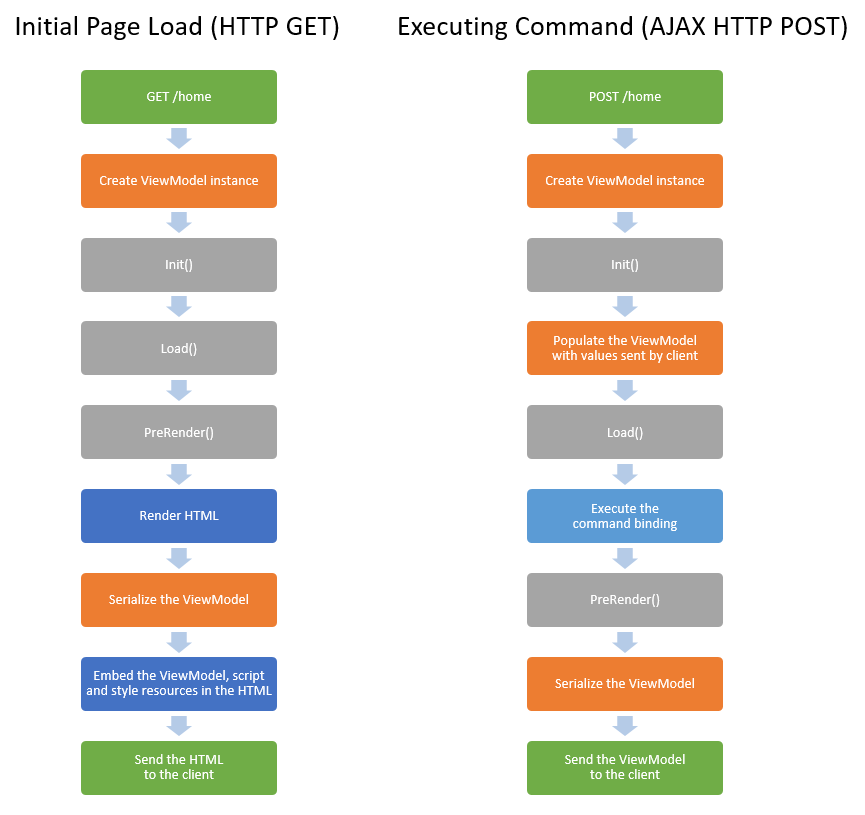ViewModels
In DotVVM, the viewmodel can be any JSON-serializable class. The viewmodel does two important things:
It represents the state of the page (values in all form fields, options for ComboBoxes etc.).
It defines commands which can be invoked by the user (e.g. button clicks).
public class CalculatorViewModel
{
// The state of the page is represented by public properties.
// If you serialize the viewmodel, you should have all the information to be able to restore the page in the exactly same state later.
public int Number1 { get; set; }
public int Number2 { get; set; }
public int Result { get; set; }
// The commands that can be invoked from the page are public methods.
// They can modify the state of the viewmodel.
public void Calculate()
{
Result = Number1 + Number2;
}
}
ViewModel Limitations
The state part of the viewmodel is done using public properties. Please note that the viewmodel must be JSON-serializable.
Therefore, a "DotVVM-friendly" viewmodel can contain properties of these types:
string,Guid,bool,intand other numeric types andDateTime, including nullable ones (e.g.decimal?)enum
another DotVVM-friendly object
collections (array,
List<T>) of DotVVM-friendly objects, enums or primitive types
Please note that the
TimeSpanandDateTimeOffsetare not supported in the current version.
Recommendations for ViewModels
The properties in viewmodel and all child objects should have plain
{ get; set; }. There should be no logic in getters, setters or the constructor of the class. The getters and setters are called by the serialization mechanism and you never know the order in which setters are invoked.The viewmodel commands are part of the presentation layer. They shouldn't communicate with the database, send e-mails etc. In general, the viewmodel methods should only gather data from the viewmodel, call some method from the business layer to do the real job and after it's finished, update the viewmodel with the results.
Please don't use Entity Framework
DbContextdirectly in the viewmodel. These things should be in lower layer than in the presentation one. Look at the samples to see how to architect the application in the layers.
We also don't recommend exposing Entity Framework entities as viewmodel properties. Remember that the viewmodel is serialized, so the user can see all the columns including various IDs which may be private.
Also, you may end with errors because of the lazy loading, which might "expand" the entities and cause big data transfers, or fail on cyclic references which are not supported in JSON.
If you are using Entity Framework, create Data Transfer Objects and use them in your viewmodel instead. You can use libraries like AutoMapper to make the mapping between entities and DTOs really easy.
DotvvmViewModelBase
We recommend to inherit all viewmodels from DotvvmViewModelBase. It is not required - any class can be the viewmodel.
But the DotvvmViewModelBase class gives you several useful mechanisms that you may need (e.g. the Context property). If you cannot use it, consider using the IDotvvmViewModel interface to be able to get the Context property and the viewmodel events.
If the viewmodel derives from the DotvvmViewModelBase, you can override the Init, Load and PreRender methods.
In the following diagram, you can see the lifecycle of the HTTP request. The left side shows what's going on when the client access the page first time (the HTTP GET request). The right side shows what happens during the postback (e.g. when the user clicks a button to call a method in the viewmodel).
